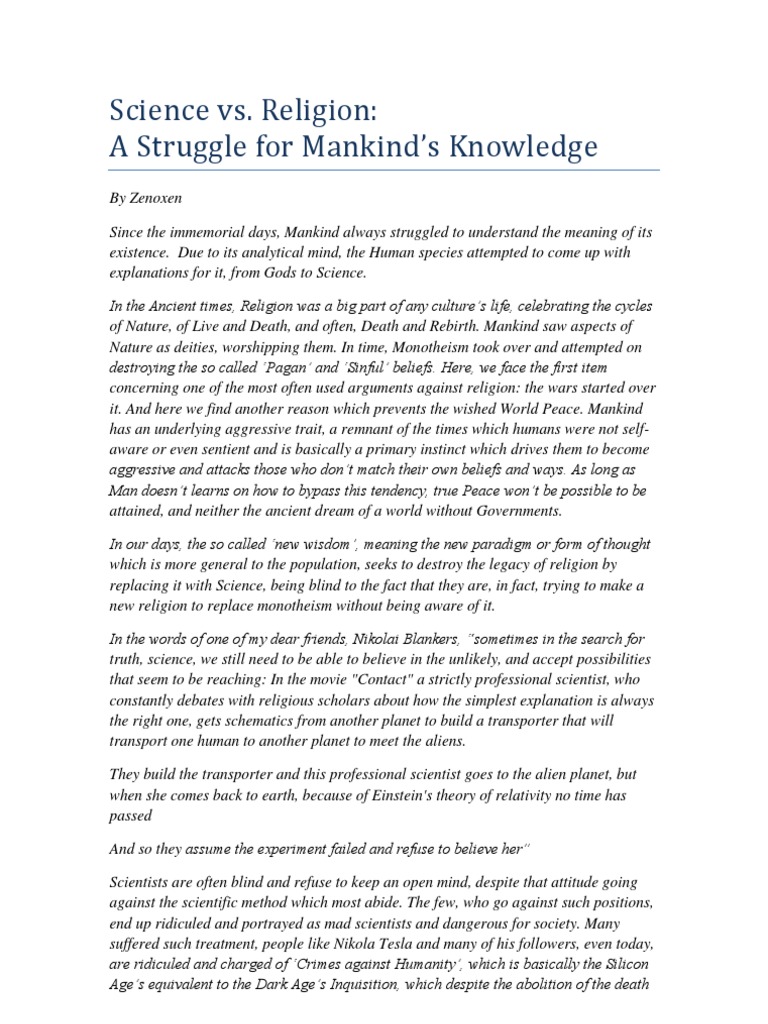The intersection of science and religion has long been a battleground of ideologies, often seen as opposing forces elucidating different realms of human experience. In Bahá’í teachings, however, this dichotomy is dismantled, revealing a harmonious symbiosis, akin to two wings of a bird—a metaphor that epitomizes the necessity of both elements for the flight of humanity towards ultimate truth. By exploring this intrinsic connection, one may discern the Bahá’í perspective that science and religion not only can coexist but must indeed find commonality for the advancement of civilization.
At the heart of Bahá’í thought lies the conviction that both science and religion are manifestations of the same divine reality, destined to support each other in the quest for understanding. The Bahá’í writings assert that the purpose of religion is to ensure spiritual growth, cultivate ethical conduct, and promote unity, while science serves to uncover the material laws governing the universe, enhancing our comprehension of the physical realm. Together, they form a comprehensive narrative about existence, reflecting the multifaceted nature of creation.
One of the central tenets of Bahá’í philosophy emphasizes that science without religion can lead to materialism and moral vacuity. Individuals who solely embrace scientific inquiry without the temperance of spiritual principles risk losing sight of ethical dimensions, ultimately culminating in a society driven by selfish desires. Conversely, religion devoid of scientific validation falls into superstition and dogmatism, leading to conflict and division. Hence, the Bahá’í teachings advocate for a coalescence of empiricism and spirituality, advocating for a more elevated understanding of life and existence.
The metaphor of light serves as a compelling illustration within Bahá’í scripture. Science is conceived as an illuminating force, shedding clarity on the physical world, much like the rays of the sun dispel the shadows. Religion, in this context, represents the source of inner illumination, guiding individuals along the ethical and moral pathways of life. When both lights converge, piercing the darkness of ignorance, they empower humanity to ascend to higher realms of knowledge and virtue.
Moreover, Bahá’í teachings elucidate the implications of this unity for humanity’s progress. The Bahá’í view posits that the advancement of civilization hinges upon the fusion of scientific advancements with spiritual principles. For instance, consider the realm of medical science. The advancements in healthcare are indisputably remarkable, yet these advancements must be complemented by ethical considerations surrounding their application. The treatment of individuals should never be reduced to mere statistics; rather, it should encompass an understanding of human dignity and the sanctity of life, which are firmly rooted in spiritual beliefs.
Additionally, the Bahá’í outlook on education exemplifies this integration of science and religion. Education is seen as the bedrock upon which the future of humanity is built. A well-rounded education that incorporates both scientific inquiry and spiritual teachings is vital for nurturing future leaders who can navigate the complexities of a global society. An educational system embracing this duality fosters critical thinkers who can address the pressing global challenges with both intellect and compassion.
Furthermore, the alignment of science and religion is indispensable for confronting existential dilemmas such as climate change. Scientific findings provide the necessary data to comprehend the urgency of the crisis, while religious narratives imbue the call for action with a sense of moral obligation. Bahá’í teachings stress the importance of stewardship of the planet—a concept echoed in numerous religious tenets. Thus, the collaboration between these two entities becomes essential for formulating sustainable solutions that are ethically grounded and scientifically informed.
Historically, moments of tension between science and religion, such as the debates surrounding Darwinian evolution, highlight the dissonance that arises when either side fails to acknowledge the validity of the other. Bahá’í discourse encourages an open dialogue, emphasizing the notion that truth is one and multifaceted. Disparate perspectives on contentious issues can often lead to deeper understanding and insights. This unity of purpose speaks to the Bahá’í commitment to fostering an inclusive global community where diverse viewpoints converge towards a shared reality.
The examples of the historical dialogue among religious and scientific thinkers resonate with the Bahá’í affirmation of the importance of consultation. Through respectful conversations and a collective pursuit of knowledge, humanity can begin to weave the diverse threads of understanding into a luminous tapestry of enlightenment. In this framework, each individual contributes uniquely to the fabric of truth and wisdom, fostering a culture where science and religion operate as partners rather than adversaries.
As such, Bahá’í teachings champion the assertion that science and religion must agree, harmonizing the empirical and the spiritual for the betterment of society. In this collective endeavor, humanity is urged to embrace the profound interconnectedness of all life, knowledge, and existence. By embracing both revelations, humanity stands poised not only to heighten individual understanding but to propel civilization towards unforeseen horizons of harmony, wisdom, and collective progress.
The vision presented by the Bahá’í faith serves not merely as an abstract ideal but as a practical guide to navigate the complexities of human experience. The agreement of science and religion remains an essential aspiration—an aspiration that calls upon humanity to rise above discord and to pursue a path illuminated by the twin lights of reason and faith.
